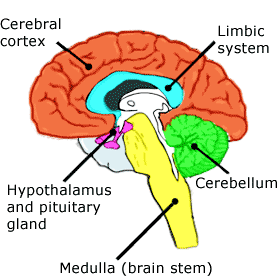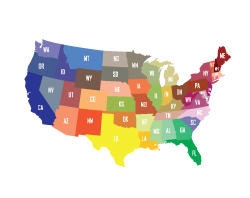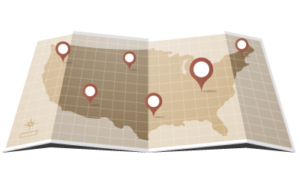Alcohol acts primarily on the nerve cells within the brain. Alcohol interferes with communication between nerve cells and all other cells, suppressing the activities of excitatory nerve pathways and increasing the activities of inhibitory nerve pathways.
For example, the University of Chicago Medical Center: Alcohol and Anesthetic Actions talks about the ability of alcohol (and inhaled anesthetics) to enhance the effects of the neurotransmitter GABA, which is an inhibitory neurotransmitter. Enhancing an inhibitor would have the effect of making things sluggish, which matches the behavior you see in a drunk person. Glutamine is an excitatory neurotransmitter that alcohol weakens. By making this excitatory neurotransmitter less effective, you also get sluggishness. Alcohol does this by interacting with the receptors on the receiving cells in these pathways.
Alcohol affects various centers in the brain, both higher and lower order.The centers are not equally affected by the same BAC – the higher-order centers are more sensitive than the lower-order centers. As the BAC increases, more and more centers of the brain are affected. The order in which alcohol affects the various brain centers is as follows:
|
||||||||||
 |
How Nerve Cells Talk
Nerve cells talk to each other and to other cells (such as muscle or gland cells) by sending chemical messages. These messages are called neurotransmitters.
An electrical signal travels down one nerve cell, causing it to release the neurotransmitter into a small gap between cells called the synapse. The neurotransmitter travels across the gap, binds to a protein on the receiving cell membrane called a receptor, and causes a change (electrical, chemical or mechanical) in the receiving cell. The neurotransmitter and receptor are specific to each other, like a lock and key. Neurotransmitters can either excite the receiving cell to cause a response or inhibit the receiving cell from stimulation.
Cerebral Cortex
The cerebral cortex is the highest portion of the brain. The cortex processes information from your senses, does your “thought” processing and consciousness (in combination with a structure called the basal ganglia), initiates most voluntary muscle movements and influences lower-order brain centers. In the cortex, alcohol does the following:
- Depresses the behavioral inhibitory centers – The person becomes more talkative, more self-confident, and less socially inhibited.
- Slows down the processing of information from the senses – The person has trouble seeing, hearing, smelling, touching and tasting; also, the threshold for pain is raised.
- Inhibits thought processes – The person does not use good judgment or think clearly.
These effects get more pronounced as the BAC increases.
Limbic System
The limbic system consists of areas of the brain called the hippocampus and the septal area. The limbic system controls emotions and memory. As alcohol affects this system, the person is subject to exaggerated states of emotion (anger, aggressiveness, withdrawal) and memory loss.
Cerebellum
The cerebellum coordinates the movement of muscles. The brain impulses that begin muscle movement originate in the motor centers of the cerebral cortex and travel through the medulla and spinal cord to the muscles. As the nerve signals pass through the medulla, they are influenced by nerve impulses from the cerebellum. The cerebellum controls fine movements. For example, you can normally touch your finger to your nose in one smooth motion with your eyes closed; if your cerebellum were not functioning, the motion would be extremely shaky or jerky. As alcohol affects the cerebellum, muscle movements become uncoordinated.
In addition to coordinating voluntary muscle movements, the cerebellum also coordinates the fine muscle movements involved in maintaining your balance. So, as alcohol affects the cerebellum, a person loses his or her balance frequently. At this stage, this person might be described as “falling down drunk.”
Hypothalamus and Pituitary Gland
The hypothalamus is an area of the brain that controls and influences many automatic functions of the brain through actions on the medulla and coordinates many chemical or endocrine functions (secretions of sex, thyroid, and growth hormones) through chemical and nerve impulse actions on the pituitary gland. Alcohol has two noticeable effects on the hypothalamus and pituitary gland, which influence sexual behavior and urinary excretion.
Alcohol depresses the nerve centers in the hypothalamus that control sexual arousal and performance. As BAC increases, sexual behavior increases, but sexual performance declines. This observation has been known for a long time, and is referred to by William Shakespeare in “Macbeth” (Act 2 scene 3):
Macduff: What three things does drink especially promote?
Porter: Marry sir, nose-painting, sleep, and urine. Lechery, sir it provokes, and unprovokes; it provokes the desire, but it takes away the performance…
The porter in the above excerpt also notes the effect of alcohol on urine excretion. Alcohol inhibits the pituitary secretion of anti-diuretic hormone (ADH), which acts on the kidney to reabsorb water. Alcohol acts on the hypothalamus/pituitary to reduce the circulating levels of ADH. When ADH levels drop, the kidneys do not reabsorb as much water; consequently, the kidneys produce more urine.
Medulla
The medulla, or brain stem, controls or influences all of the bodily functions that you do not have to think about, like breathing, heart rate, temperature and consciousness. As the alcohol starts to influence upper centers in the medulla, such as the reticular formation, a person will start to feel sleepy and may eventually become unconscious as BAC increases. If the BAC gets high enough to influence the breathing, heart rate, and temperature centers, a person will breathe slowly or stop breathing altogether, and both blood pressure and body temperature will fall. These conditions can be fatal.
For more information on the parts of the brain and their functions, see Alcohol’s Effects.
Alcohol’s Effects on Other Body Systems
In addition to the brain, alcohol can affect other body tissues. It has the following effects on other systems in the body:
- Irritates the linings of the stomach and intestine – This can lead to vomiting.
- Increases blood flow to the stomach and intestines – This increases secretions by these organs, most notably stomach acid secretion.
- Increases blood flow to the skin – This causes a person to sweat and look flushed. The sweating causes body heat to be lost, and the person’s body temperature may actually fall below normal.
- Reduces blood flow to muscles – This can lead to muscle aches, most notably when a person recovers from the alcohol (the “hangover”).
All of the alcohol’s effects continue until the ingested alcohol is eliminated by the body.







